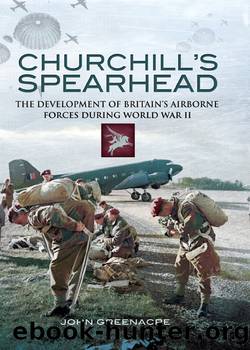Churchill's Spearhead by John Greenacre

Author:John Greenacre
Language: eng
Format: epub
ISBN: 9781844685806
Publisher: Pen & Sword Books
This represents a relatively sophisticated approach to training. Complicated missions are reduced to a number of simpler tasks each of which are then given a related training objective. Each of these training objectives could therefore be achieved in isolation as time allowed and still contribute towards the success of the overall mission.
As an operation became imminent and objectives were revealed, planning could be conducted down to unit and sub-unit level. Those units and sub-units could then focus their training very precisely on achieving their own specific objectives. In conventional land-bound operations leaders at all levels could have an opportunity to see the ground they were due to fight over. Prior to offensive operations the lie of the land could be studied from observation points or during reconnaissance activity. During defensive operations the ground might be occupied already and would be intimately familiar to all the defenders.
Airborne leaders and soldiers did not have this luxury. The ground they would fight over might be hundreds of miles away over completely unfamiliar terrain with foreign features. Very few would be able to fly over the ground prior to an operation; the risks were too high. Most leaders would have to make do with maps and aerial photographs. The information available in these formats could be enhanced by combining the two and building scale models. The use of models was not unique to airborne operations but they were used extensively prior to all levels of action from minor raids to divisional assaults.196 In one case this technique was ingeniously adapted to provide a highly sophisticated training aid.
A model of the Orne bridgehead was built to assist the glider pilots prior to D-Day. A No. 38 Group officer, Squadron Leader Lawrence Wright conceived the idea of making a film of the model. Chatterton recalled the results. âBy using a blue filter on his 16 mm Camera, and by holding the camera at a calculated height, he produced a remarkable film for briefing. It gave a complete picture of a glider coming in from 1,000 feet, down to about 100 feet, and provided a most realistic impression of what the landing in Normandy might be like.â197 The camera was rigged from the ceiling using a series of wires. Chatterton maintains that the film was of great assistance to the pilots. Staff Sergeant Jim Wallwork, the commander of the first glider to land in Normandy, recalls seeing the film just once or twice and considers that it was of novelty value only.198 While this initiative represented a very modern approach, along with all models it really only represented an aid to briefing as opposed to practical training.
Training in an environment designed to imitate a known objective is an activity militarily defined as rehearsals. Rehearsals were recognised as an important aspect of training early in the airborne development process.199 For rehearsals to be valuable they had to be conducted in an environment that replicated the real objective as closely as possible. Due to this, rehearsals were only really applicable to small-scale actions, up to battalion level.
Download
This site does not store any files on its server. We only index and link to content provided by other sites. Please contact the content providers to delete copyright contents if any and email us, we'll remove relevant links or contents immediately.
De Catalaanse brief by Robert Goddard(317)
A Piece of Cake by Sarah Swatridge(250)
Churchill's Spearhead by John Greenacre(226)
Nonlinear Dynamics and Chaos with Student Solutions Manual by Steven H. Strogatz(219)
The Ruin of J. Robert Oppenheimer by Priscilla J. McMillan(192)
Flowering of the Cumberland by Harriette Simpson Arnow(172)
Popular Culture and Political Identity in the Arab Gulf States by Alanoud Alsharekh Robert Springborg(171)
thing bounces back europe by Unknown(163)
Allied Bombing Raids by Philip Kaplan(162)
A Japanese View of Nature by Kinji Imanishi Pamela J. Asquith(156)
Guild and State by Antony Black(151)
Comet Madness by Richard J. Goodrich(151)
RAF at the Crossroads by Greg Baughen(139)
History Without A Subject by David Ashley(134)
A History of Greek and Roman Philosophy by John Hackney(133)
The Seventies Now: Culture As Surveillance by Stephen Paul Miller(133)
A History of Science in Society by Ede Andrew;Cormack Lesley B.;(130)
Air Battle for Burma by Evans Bryn;(127)
Shocking Bodies by Iwan Rhys Morus(125)
